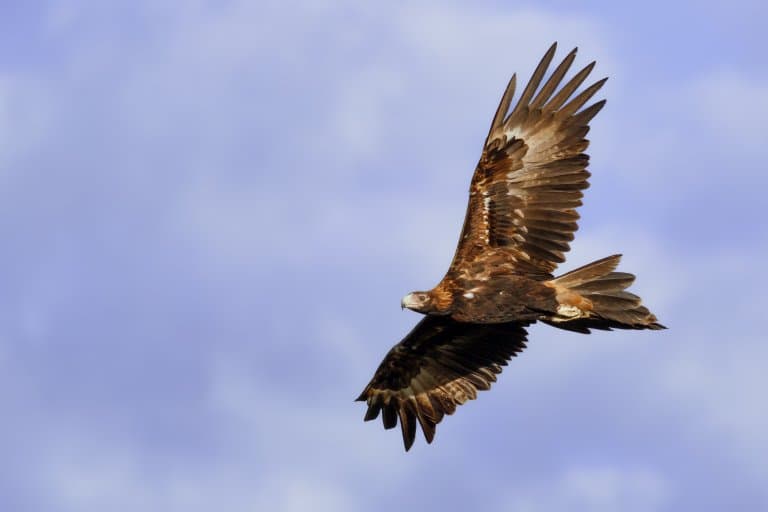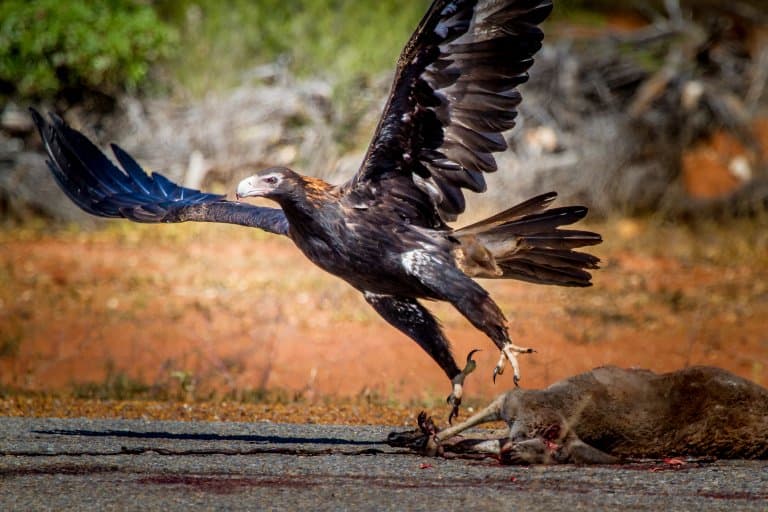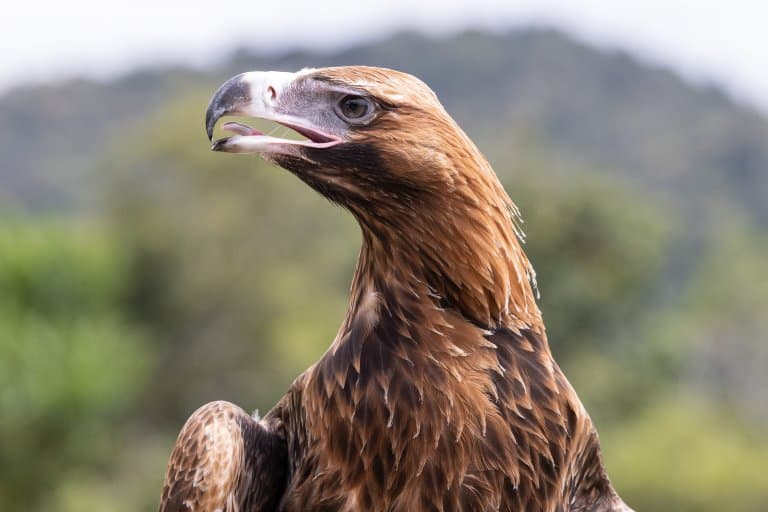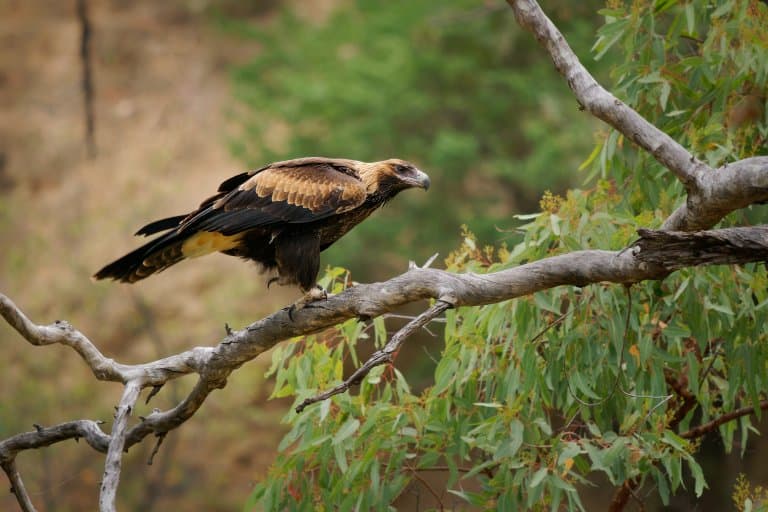Wedge-Tailed Eagle Profile
Legend has it that in 1966, Barton Lee Hazlewood wrote a song about these birds. Upon hearing it, Nancy Sinatra made a few minor tweaks and turned it into a masterpiece that topped the UK charts that same year.
By the time it hit the radio, all mentions of the bird were absent, but the theme of pride, conquest and independence remains, and today’s eagle has that in buckets.
Wedge-tailed eagles are the largest bird of prey found throughout Australia, Tasmania and southern New Guinea. They are part of a group of eagles known as ‘booted eagles” (this is not to be confused with The booted eagle, Hieraaetus pennatus, which is in a closely related genus).
Booted eagles are named for their distinctive feathery legs. Most eagle species have bare, scaly legs like those of an old rice farmer. But these eagles have taken the fashion of 2010 and run with it.

Wedge-Tailed Eagle Facts Overview
| Habitat: | Forest, savanna, scrubland, grassland |
| Location: | Australia |
| Lifespan: | More than 50 years |
| Size: | Up to 284 cm (9 ft 4 in) wingspan |
| Weight: | Possibly up to 4.7 kg (10 lb), maybe 5km + |
| Colour: | Dark brown and black |
| Diet: | Varied, mostly vertebrates, from lizards to large mammals |
| Predators: | None |
| Top Speed: | Unknown |
| No. of Species: | 1 |
| Conservation Status: | Least Concern (IUCN) |
These formidable birds are some of the biggest avian predators in the world.
Their distinctive hooked beak and classic eagle glare make them archetypal for the order, but their shaggy boots set them apart from most.
The wedge-tailed eagle lives in most habitats in Australia, from desert bush, to forests, to open plains and grassland areas. They have a preference for rocky areas with open terrain to hunt.
They’re exceptionally successful, specialised for hunting in daylight and adaptable to almost any prey source. They will diet on small mammals such as rabbits, as well as those much larger – even kangaroos and walabies are not off the menu, alongside other birds and reptiles.
As such, they’re a threat to anything with a spine, and even some light aircraft…
Interesting Wedge-Tailed Eagle Facts
1. These boots are made for killing
There are nine genera and around thirty species of booted eagles, including many in the well-known Aquila genus.
Wedge-tailed eagles are among them, and while many species have this adaptation as an obvious advantage in frosty weather, this isn’t such a concern for an Australian species. Instead, it’s thought that the largest raptor on the continent makes use of the extra protection when grappling with dangerous prey.
Because, of course, even the prey animals are dangerous in Australia. 1

2. This is one of the most powerful predatory birds
This is an enormous eagle. This species holds the record for the largest wingspan for an eagle, at over 2.8 meters across, though on average it’s smaller than the Stellar’s sea eagle. It’s also one of the heaviest, at over 4kg in weight, with some sources claiming it surpassed 5kg.
Even their nests are big, which can reach 2 metres in diameter and 4 metres deep.
When hunting, this eagle spots its victims from up to a kilometre away and can be engaged at the culmination of a long, angled stoop.
This eagle is adept both in open plains and woody areas, and almost all its victims are terrestrial, though they will also take birds in branches. They’ll even drag mammals out of crevices and steal young from nests.
Because of their huge size, they’re capable of bullying other predators off their kills, and as if the residents of the forest weren’t already having a bad enough day, these eagles have been seen following wildfires to capitalise on the fleeing animals.
Wedge-tailed eagles can carry off animals as heavy as 5kg in weight! Mean prey weight in one study was around 1.3kg, including many rabbits and large lizards, though they will also feed on adult kangaroos, and can take wallabies, wombats and other reasonably heavy mammals. 2
3. They even team up
With the extinction of Argentavis around six million years ago, this immense aerial threat is something most mid-to-large mammals in the world no longer have to worry about.
But wedge-tailed eagles are keeping the fear alive in Australia, and if you think you’re safe from one pesky eagle, you might be surprised when they work together.
When these birds decide they want to hunt something bigger, like an adult kangaroo, they’re not above collaborating. Teams of eagles have been seen taking turns to tire their opponent, even succeeding in bringing down males of one the larger species of kangaroo, the Eastern Greys.
The intrepidity of this archosaur led to its scientific name, Aquila audax, which translates to “bold eagle”. 3

4. Wedge-tailed eagles have atttacked light aircraft
Wedge-tailed eagles are territorial, particularly in the breeding season, and have been known to attack anything that flies into their airspace.
Records of hang gliders, model aeroplanes, and even helicopters and fixed-wing planes being attacked by these birds are legitimate.
This obviously poses a threat to people in the aircraft but is likely a far greater risk to the soft-bodied bird in danger of colliding with rotors or propellors.
5. Their eyes are highly specialised
This is a bird whose vision is highly specialised for hunting in bright daylight. They see in extremely high resolution, and it’s thought they can take in a far wider field of vision with photoreceptors that are 1/3 smaller and more densely packed than that of humans.
But, much like a digital camera, this eye works best in the bright natural light of day. As daylight lessens, there’s a rapid decrease in visual ability in these birds, and much like chickens, in low light, they are essentially blind. 4

6. Siblicide occurs occasionally
Wedge-tailed eagles mate for life, and once a pair is formed, they will find a large territory and defend it together.
Wedge-tailed eagles will nest in tall trees, and typically lay a couple of eggs, but can lay up to four. The female will predominantly incubate the eggs, and one or two chicks will hatch.
After a couple of weeks, sibling aggression tends to happen and often in the parents presence. The parent will make no attempt to stop this.
When food is limited, the larger of the siblings may kill and eat their smaller sibling. This is known as siblicide and is fairly common in birds of prey. For wedge-tailed eagles, this only occurs when there is scarce resources, rather than at anytime that can occur in other species.
Often the larger sibling will be the first born, so the first egg has a higher chance of survival.
7. They like to eat rabbits
In several populations, their appetite for invasive rabbits has not gone unnoticed. On the arid Nullarbor Plain, rabbits were by far the major food item despite the presence of several other prey species.
Elsewhere, foxes, cats, and sheep are taken, some of which have historically led to the species being persecuted as a pest – something which has now been banned. But in areas where they prioritise eating rabbits, it has been wondered whether the species might provide an ecological service.
8. They may benefit from invasive rabbits
Understanding the relationship between these incredible eagles and the armies of rabbits rampaging across Australia is important for the birds’ protection.
The question is: if eagle populations rely entirely on the rabbit, how can conservationists eradicate the invasive species without harming the eagles?
Many of the responses to the rabbit threat have been viral and abhorrent in nature. Rabbit haemorrhagic disease virus (RHDV) basically ruptures the internal organs of the rabbits, giving them a slow and painful death that spreads quickly among populations.
Regardless of the tortuous nature of the virus, it’s an effective mode of genocide, and research suggests that even in areas where rabbit populations were reduced by 90% elsewhere, eagles didn’t suffer.
Sadly, this precedent is suggested as a rational framework for widespread and horrific biological control methods against pests in Australia. 5

9. Kangaroos are probably more important
The adaptable nature of this bird means that removing one prey source simply results in them finding another. In populations with fewer rabbits, the diet is very diverse, and one study showed a breeding population’s food sources came mostly from reptiles.
20% of their kills were juvenile kangaroos and 68% were bearded dragons. However, in terms of biomass, these proportions were reversed, meaning they got 73% of their lunch from kangaroo meat and 21% from reptiles.
Still, rabbits were taken in proportion to their abundance, suggesting that they still taste pretty good to the eagles.
Being so spoiled for choice among the vertebrate fauna of Australia, these eagles have a really high survival rate. They’re listed as of Least Concern by the IUCN and don’t appear to be changing any time soon.
10. They have bounced back after heavy persecution
Like many large birds of prey across the globe, the wedge-tailed eagle has historically been heavily persecuted by humans, through both poisoning and shooting.
This is largely due to their perceived predatation of farm animals, particularly sheep during a period when Australia had an establishment of large-scale sheep farming in the early 1900’s.
Amazingly, laws were introduced for landowners to kill eagles as vermin and 120,000 bounties were paid in the states of Queensland and Western Australia for wedge-tailed eagles alone.
Legal protections were then introduced in the 1950s, and stricter still in the 1970s.
Since then, wedge-tailed eagles have bounced back incredibly, to perhaps higher population numbers than pre persecution – partly due to humans providing rabbits as an invasive species, and roadkills as carrion!
Wedge-Tailed Eagle Fact-File Summary
Scientific Classification
| Kingdom: | Animalia |
| Phylum: | Chordata |
| Class: | Aves |
| Order: | Accipitriformes |
| Family: | Accipitiridae |
| Genus: | Aquila |
| Species: | Aquila Audax |
Fact Sources & References
- Amadon, Dean (1982), “The Genera of Booted Eagles: Aquila and Relatives”, Sci Hub.
- “Wedge-tailed Eagle – Aquila audax”, Carnivora net.
- Esteban Fuentes (2015), “Observations of the killing of large macropods by Wedge-tailed Eagles ‘Aquila audax’”, Informit.
- Liz Reymond (2015), “Spatial visual acuity of the eagle Aquila audax: a behavioural, optical and anatomical investigation”, Sci Hub.
- Jerry Olsen (2014), “Is wedge-tailed eagle, Aquila audax, survival and breeding success closely linked to the abundance of European rabbits, Oryctolagus cuniculus?”, CSIRO PUBLISHING.
